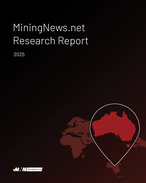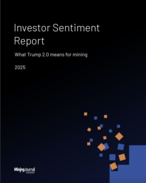This article is 11 years old. Images might not display.
One of the main problems is the Bulldog shale, a unit within the barren Eromanga Basin sediments and the source of the district’s black soil plains.
The shale is rich in sedimentary pyrite, a highly conductive and worthless iron sulphide that plays havoc with the electromagnetic exploration tools of the modern prospector.
At thicknesses of more than 50m, the black soil plains create an almost impenetrable, electrical barrier to the detection in deeper rocks of economic sulphides of copper, lead, zinc and more exotic and valuable metals.
The southern reaches of the district also have graphitic basement units, creating another form of electromagnetic mask.
But new technology is rising to the challenge, and at least two explorers —Minotaur Exploration and Inova Resources (formerly Ivanhoe Australia) — are on the brink of learning whether they finally have the tools to unlock the mineral secrets of the Cloncurry district.
Adelaide-based Minotaur is confident that extensive trials and experimentation with several high-tech exploration tools have dramatically shortened the odds of finding orebodies in Cloncurry.
Executive director Dr Tony Belperio told MiningNewsPremium that the “ultra-conductive” cover of the Eromanga Basin blocked 99% of the electromagnetic signal.
“We’re trying to force the signal through and pick up a very low return. There’s a lot of noise that has to be filtered.”
“We have been trialling all sorts of systems, including SquitEM, BField EM, various VTEM systems as well as deep penetrating IP. There’s a lot of work that goes on that shareholders don’t see results for in the short term.”
The SquitEM system is a proprietary technology developed by the Japan Oil, Gas and Metals National Corporation (JOGMEC), which became Minotaur’s joint venture partner at Cloncurry in 2010.
SquitEM is a modified version of time domain electromagnetic systems. It relies on high temperature superconductors, which were one of the major physics discoveries of the 1980s.
Belperio said there were only a handful of SquitEM systems available worldwide, and they were not easy to use in the field.
“SquitEM has been important because it allowed to see for the first time the target depths we needed to reach.
“We have been able to match those results through a lot of experimentation with off-the-shelf systems. We’re fortunate in that we have two geophysicists in house with a lot of field experience, and they are very good at mixing and matching equipment to get results.
“Depending on the deposit style, whether its Ernest Henry, Osborne, Eloise or Prominent Hill style, and the local cover sequence, we have now been able to detect primary mineralisation through more than 200m of ultra-conductive cover.
“We are continuing to refine and build upon in addition to utilising in our various Cloncurry programs,” Dr Belperio said.
Minotaur’s confidence in its new remote-sensing techniques is based on recent drill results that have the company’s veteran exploration team quietly excited.
Belperio said the company had intersected sulphides as predicted at depths of 200m. These were not economic sulphides, but with each new drill hole the odds of discovery are shortening.
Inova has an even longer history of innovative exploration in the Cloncurry district, including a seismic exploration survey in 2009.
The company began life in 2003 as the Australian subsidiary of Robert Friedland’s Ivanhoe Mines.
One its primary objectives was to deploy the deep penetrating Induced Polarisation (IP) survey methods that had been instrumental in the discovery of the giant Oyu Tolgoi copper-gold deposit in Mongolia.
After Rio Tinto took control last year, Inova experienced large cuts to its operating and capital spending, but it remains one of the most active explorers in the country, with an annual exploration budget of $10-$15m.
The company last month appointed Mark McGeough as general manager, exploration. He was formerly the head of exploration at Toro Energy, a role he took up after a highly successful stint as manager of South Australia’s Geological Survey.
Inova’s exploration activity is centred around its Merlin molybdenum/rhenium deposit and Osborne copper-gold mine, about 120km and 170km south of Cloncurry respectively.
McGeough told MNP that graphitic siltstones and shales made these locations difficult for the most common electromagnetic methods.
“Graphite is a problem in many areas because it is conductive, but it is not so easily picked up by chargeability, which is one of the reasons we use induced polarisation.
“IP will discriminate sulphide from graphite. It will not tell you if you have found pyrite or a sulphide orebody, but at least you know you are going to drill into sulphide.”
Inova is a specialist in using 3D IP, which is still in limited use by Australian explorers even in 2D form.
3D IP is a computer-heavy approach that fills in the picture between IP lines at spacings of either 400m or 800m.
The disadvantage of 3D IP is the small area of ground it can cover, typically measured in the tens of square kilometres. This is an order of magnitude less than airborne electromagnetic systems.
Inova solved this problem with a seismic survey in late 2009, which capitalised on the fact that Geoscience Australia had brought equipment into the area to conduct some regional traverses.
“We saw it as an opportunity to map out major faults in the area, especially those that did not have an expression at the surface. We could then apply some of the magnetic and gravity information to identify the major structural corridors, where mineralisation is most likely to be found.
“We use seismics, magnetics and gravity to look at the structural context and then IP to detect the sulphides and complete our drill targeting. We have different layers to try and get to targets that can be quite small,” McGeough said.
He said another reason for using seismic was to see if the structures that host the Merlin deposit could be seen.
“Molybdenum is quite a difficult mineral to detect. It’s not picked up by any geophysical method, so they were hoping would help define the structures where it was found.”
Inova’s four major seismic lines cost more than $1m, which makes it expensive compared to traditional mineral exploration methods. But the seismic successfully generated the information that Inova hoped for across its major areas of interest.
One of the conceptual targets identified by the process that began with the 2009 seismic survey was known as Barry. The target, which lies 6km west of the Starra line of mineralisation, is due to be drilled in the next fortnight. A number of additional targets in the Mount Elliott project area will also be drill tested in the September quarter.
McGeough said Inova would soon begin testing new IP systems that had been developed to find sulphides at much greater depths.
“IP can normally see down to 200m or 300m but it gets very difficult to see a target at those depths. We’re looking now at a system that can get down to 400m or 500m, and some claim even 600m, although I am bit dubious about that. That’s our next work which will kick off in a couple of months.”























